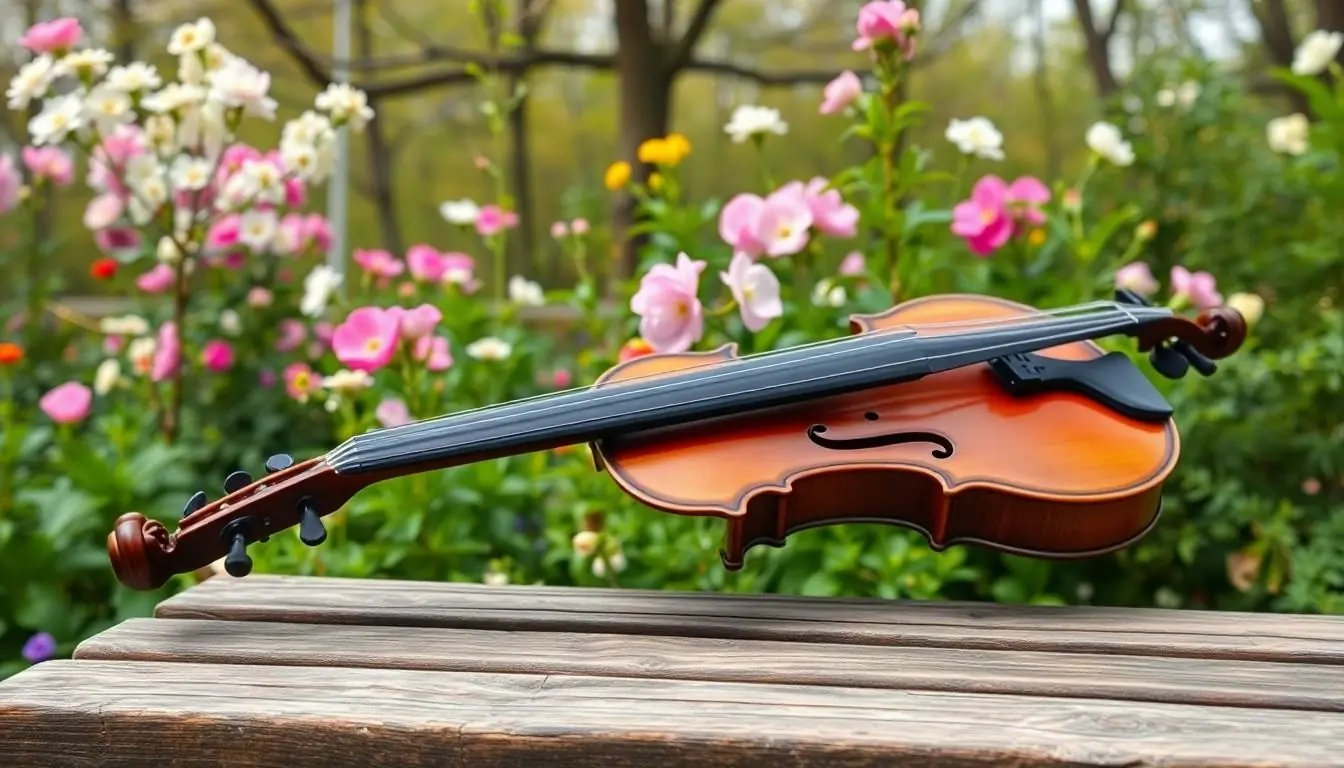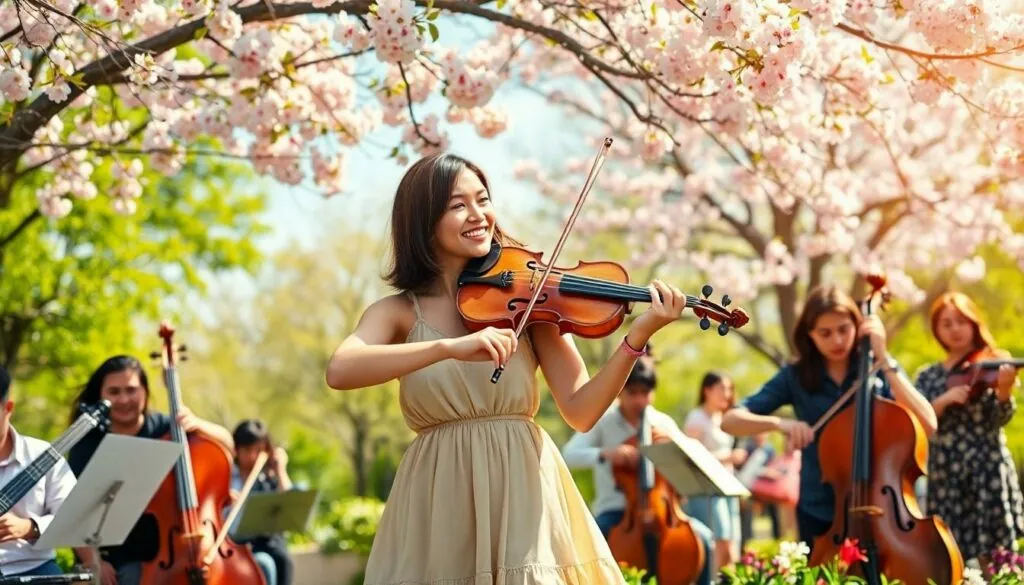Table of Contents
ToggleAs winter bids farewell and flowers start to bloom, the world awakens to the symphonic sounds of spring. It’s that magical time when classical music takes center stage, inviting listeners to indulge in a delightful auditory experience. Imagine the gentle rustle of leaves and the chirping of birds harmonizing with the melodies of renowned composers. It’s not just a seasonal shift; it’s a full-on concert for the senses.
Overview Of Spring Classical Music
Spring classical music captures the essence of renewal and vibrancy often associated with the season. Composers such as Vivaldi, Beethoven, and Mendelssohn have crafted works that reflect the beauty of blooming flowers and lively fauna. The lightness of these compositions resonates with audiences, evoking images of nature awakening.
Vivaldi’s “The Four Seasons,” particularly “La Primavera” (Spring), stands out as a defining piece. This concerto encapsulates the joy of the season, featuring energetic violin passages and delicate harmonies. It illustrates the interplay of vibrant melodies mimicking the sounding nature, encouraging imagination.
Beethoven’s “Symphony No. 6” also embraces spring’s spirit. Nicknamed “Pastoral,” this work portrays rural life and its connection to the natural landscape. Gentle themes convey tranquil scenes, leading listeners through serene meadows and lively brooks.
Mendelssohn’s “A Midsummer Night’s Dream” highlights spring’s whimsical qualities. The overture, with its enchanting themes, evokes fantasy and anticipation, a fitting tribute to the season’s magic. Such pieces enhance the collective auditory experience, uniting classical music with the vibrancy of spring.
Listeners often find classical music provides a backdrop to outdoor activities during spring. Its soothing melodies complement picnics, walks in the park, or simply enjoying the beauty of nature. These musical selections contribute to a rich auditory tapestry, deepening appreciation for the season’s delights.
Through notable works, spring classical music beautifully complements the rejuvenating atmosphere of this vibrant time, creating a full sensory experience.
Key Composers Of Spring Classical Music

Spring classical music features several iconic composers whose works encapsulate the spirit of the season. These musicians convey renewal, vibrancy, and natural beauty through their compositions.
Johann Sebastian Bach
Bach’s contributions to spring classical music include a variety of sacred and secular works that evoke themes of renewal. His cantatas, particularly “Ich habe genug,” connect deeply with themes of rebirth and hope. The vibrant melodies reflect the energy and joy found in blooming landscapes. Many listeners appreciate how these compositions complement outdoor springs activities, enhancing the overall experience of the season.
Antonio Vivaldi
Vivaldi’s most famous work, “The Four Seasons,” remains a cornerstone of spring classical music. In “La Primavera,” Vivaldi illustrates the arrival of spring through lively and energetic violin parts, vividly portraying the sounds of nature awakening. This concerto showcases lightness and brightness, capturing the essence of the season beautifully. Numerous performances and adaptations highlight its significance in celebrating spring, making it a perennial favorite among classical music lovers.
Notable Spring Classical Music Pieces
Spring classical music reflects themes of renewal and joy. Several notable pieces capture the essence of the season.
“Spring” from Vivaldi’s Four Seasons
Vivaldi’s “Spring” from The Four Seasons epitomizes the spirit of the season. Lively violin melodies mimic the sounds of nature awakening. The opening movement showcases crisp notes that suggest the arrival of spring, symbolizing blooming flowers and chirping birds. Following sections continue to build this lively atmosphere, depicting the vibrancy of spring landscapes. Musicians interpret the energetic passages to enhance the emotions tied to new beginnings. Its lasting popularity ensures “Spring” remains a staple in classical music repertoire.
Mendelssohn’s “A Midsummer Night’s Dream”
Mendelssohn’s A Midsummer Night’s Dream captures the whimsical nature of spring. The overture sets a magical tone, filled with light and playful motifs that evoke enchanting imagery. Distinctive themes reflect the charm of blooming gardens and festive gatherings. Notably, the “Wedding March” adds joy, perfect for celebrating seasonal unions. Pianists and orchestras alike bring this piece to life, showcasing its delicate nuances and vibrant energy. Its relevance during the spring season makes it a cherished work among audiences and musicians.
Thematic Elements In Spring Classical Music
Spring classical music resonates with themes of renewal and vibrancy. Nature’s awakening inspires compositions that reflect the beauty of the season. For example, Vivaldi’s “La Primavera” features energetic violin passages that mimic the sounds of chirping birds and rustling leaves, capturing the essence of spring. Notably, its lively melodies invigorate listeners, evoking images of blooming flowers.
Beethoven’s “Symphony No. 6,” known as “Pastoral,” showcases serene rural scenes and tranquil rivers. This composition immerses audiences in the peaceful sounds of nature. Mendelssohn’s “A Midsummer Night’s Dream” brings whimsical qualities to life. Joyful motifs encapsulate the charm of blossoming gardens and festive gatherings.
Johann Sebastian Bach’s cantatas, particularly “Ich habe genug,” resonate deeply with themes of rebirth and hope. Such pieces elevate outdoor activities, creating an enriched environment filled with joy. Additionally, the interaction between musicians playing Vivaldi, Beethoven, and Mendelssohn demonstrates the flourishing spirit of spring.
The lively melodies from Vivaldi’s “Spring” embody nature’s awakening with crisp notes symbolizing new beginnings. Mendelssohn’s pieces enhance celebrations, making these works staples in classical repertoire. Audiences experience a rich auditory tapestry that complements the rejuvenating atmosphere of the season, making these compositions essential during spring months.
The Influence Of Nature On Spring Music
Nature significantly shapes the themes and emotions found in spring classical music. Composers capture the essence of the season through sound, embodying the vibrancy and renewal that spring brings. Vivaldi’s “La Primavera” expertly mimics birdsong and rustling leaves, allowing listeners to feel nature’s awakening.
Beethoven’s “Symphony No. 6” offers serene pastoral scenes, immersing audiences in the tranquility of rural landscapes. This symphony reflects the peaceful ambiance of blooming flora, inviting listeners to connect with the beauty around them. Mendelssohn’s “A Midsummer Night’s Dream” portrays enchantment through lively orchestration that mirrors the whimsical atmosphere of springtime gatherings.
Composers like Bach also resonate with the season’s themes. His cantatas often explore rebirth and hope, reinforcing the joy of outdoor activities during spring. Community events often incorporate these works, enhancing the overall experience of enjoying nature while appreciating classical music.
The auditory tapestry created by spring compositions enriches everyday life. Musicians interpret these works in ways that reflect the flourishing spirit of the season, promoting a sense of joy and connection. Such interactions create an engaging environment, encouraging audiences to embrace the sounds of renewal.
Spring classical music embodies nature’s influence profoundly. As flowers bloom and life reemerges, the melodies of these composers serve as a tribute to the season’s beauty and vibrancy. The joy found in these compositions resonates deeply, enhancing the experience of spring for all who listen.
Spring classical music serves as a vibrant soundtrack to the season’s awakening. The works of composers like Vivaldi, Beethoven, and Mendelssohn encapsulate the essence of renewal and joy found in nature. Their melodies not only enhance outdoor experiences but also create a rich auditory environment that resonates with listeners.
As flowers bloom and life flourishes, these compositions invite everyone to immerse themselves in the beauty of spring. The interaction between music and nature fosters a deeper appreciation for the season, making it a perfect time to explore and enjoy the enchanting world of classical music. Embracing these timeless pieces can transform ordinary moments into extraordinary celebrations of life and renewal.





